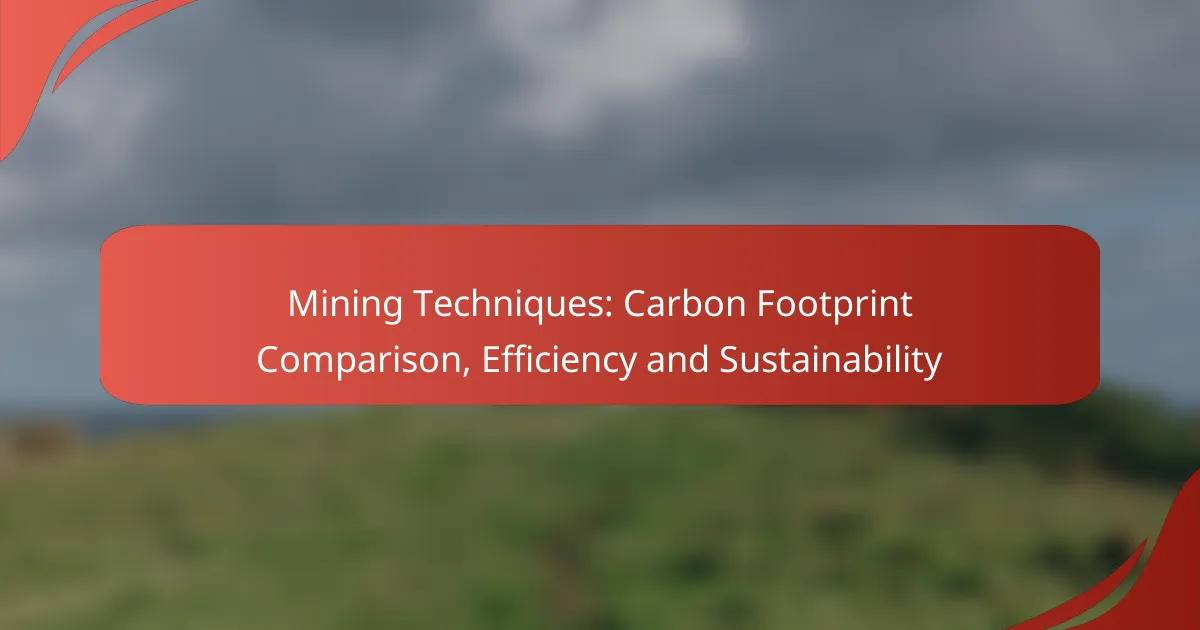Mining techniques play a crucial role in determining the carbon footprints associated with resource extraction, with different methods yielding varying emissions profiles. While open-pit mining often results in higher emissions due to extensive land disturbance, underground mining can offer a lower carbon footprint, contingent on the energy sources employed. To enhance sustainability, the industry is increasingly adopting efficient practices that prioritize resource extraction while minimizing environmental impact through the use of renewable energy and responsible resource management.
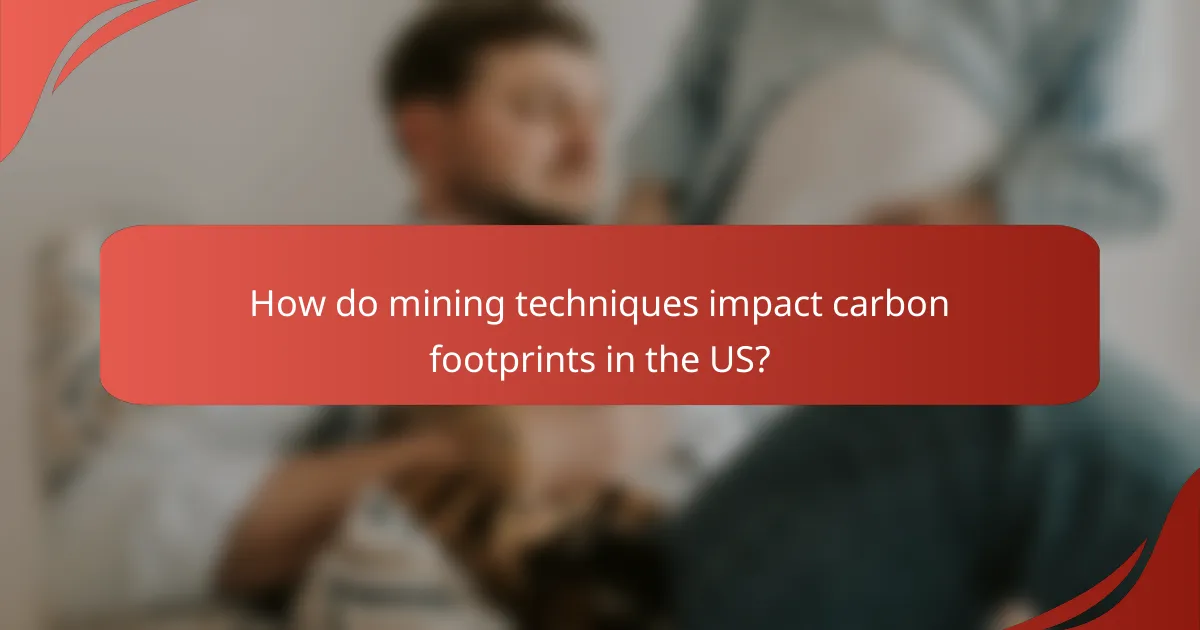
How do mining techniques impact carbon footprints in the US?
Mining techniques significantly influence carbon footprints in the US, with variations in emissions based on the method used. Open-pit mining tends to produce higher emissions due to land disturbance and equipment use, while underground mining generally has a lower carbon footprint but can still contribute substantially depending on energy sources.
Open-pit mining carbon emissions
Open-pit mining involves removing large quantities of earth to access minerals, resulting in considerable carbon emissions. The heavy machinery used, such as trucks and excavators, consumes significant fossil fuels, contributing to greenhouse gas emissions. Additionally, the land disruption can lead to increased carbon release from soil and vegetation.
For example, open-pit operations can emit several hundred tons of CO2 per day, depending on the scale of the operation and the type of fuel used. Companies are increasingly exploring ways to mitigate these emissions through more efficient machinery and renewable energy sources.
Underground mining carbon emissions
Underground mining typically has a lower carbon footprint compared to open-pit mining, as it requires less surface disturbance and can be more energy-efficient. However, it still generates emissions primarily from ventilation systems and equipment operation. The depth of the mine and the method of extraction can significantly affect the overall carbon output.
In some cases, underground mining can produce emissions in the range of tens to hundreds of tons of CO2 per day, influenced by the energy sources powering the operations. Utilizing electric or hybrid machinery can help reduce these emissions further.
Comparison of emissions by technique
When comparing emissions from open-pit and underground mining, open-pit mining generally results in higher carbon outputs due to its operational scale and equipment usage. Underground mining, while more efficient, can still contribute significantly to emissions based on energy consumption and ventilation needs.
A practical approach for companies is to conduct lifecycle assessments to understand the total emissions associated with each technique. Transitioning to renewable energy sources and implementing energy-efficient technologies can help reduce the carbon footprint of both mining methods.

What are the most efficient mining techniques?
The most efficient mining techniques focus on maximizing resource extraction while minimizing environmental impact and operational costs. Methods such as hydraulic mining, room and pillar mining, and continuous miner technology each offer unique advantages and considerations for efficiency and sustainability.
Hydraulic mining efficiency
Hydraulic mining utilizes high-pressure water jets to dislodge rock and soil, allowing for the extraction of gold and other minerals. This technique can be highly efficient in terms of resource recovery, particularly in alluvial deposits, but it often raises significant environmental concerns due to water usage and sediment displacement.
To enhance efficiency, operators should assess water sources and implement sediment control measures. However, regulations in many regions restrict hydraulic mining due to its potential for ecological damage, so it’s crucial to stay informed about local laws and best practices.
Room and pillar mining efficiency
Room and pillar mining involves creating a network of rooms and pillars to support the mine while extracting minerals, typically in coal or gypsum deposits. This method allows for a high recovery rate, often exceeding 70%, while maintaining structural integrity.
Efficiency can be improved by optimizing the layout and size of the rooms and pillars based on the specific geology of the site. However, careful planning is essential to prevent collapse and ensure worker safety, making it important to conduct thorough geological surveys before implementation.
Continuous miner technology
Continuous miner technology employs a machine that cuts and gathers material simultaneously, streamlining the mining process. This method is particularly effective in underground coal mining, where it can significantly reduce labor costs and increase production rates.
To maximize efficiency, operators should ensure that the continuous miner is well-maintained and properly calibrated for the specific conditions of the mine. Additionally, integrating real-time monitoring systems can help optimize performance and reduce downtime, making this technology a valuable asset in modern mining operations.
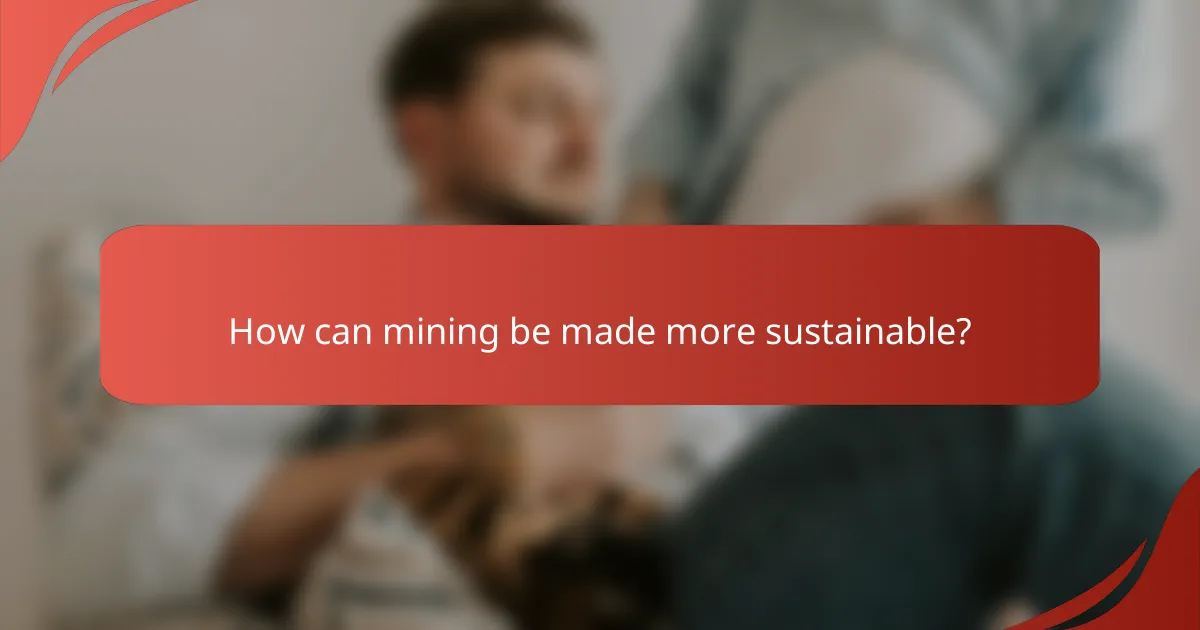
How can mining be made more sustainable?
Mining can be made more sustainable by integrating practices that minimize environmental impact while maximizing resource efficiency. Key strategies include utilizing renewable energy sources, implementing effective reclamation practices, and managing water resources responsibly.
Use of renewable energy in mining
Incorporating renewable energy, such as solar or wind power, can significantly reduce the carbon footprint of mining operations. Many mines are now investing in solar panels or wind turbines to power their facilities, which can lead to substantial cost savings over time.
For example, a mine that shifts to renewable energy may reduce its reliance on fossil fuels by 30-50%, depending on the energy mix available in the region. This transition not only lowers greenhouse gas emissions but can also enhance energy security.
Reclamation practices in mining
Reclamation practices involve restoring mined land to its natural state or repurposing it for other uses after mining activities cease. Effective reclamation can help mitigate the long-term environmental impacts of mining, such as soil degradation and habitat destruction.
Common reclamation techniques include replanting native vegetation, creating wetlands, and contouring land to prevent erosion. Successful reclamation can lead to the restoration of ecosystems and improve biodiversity, making it a critical aspect of sustainable mining.
Water management strategies
Water management is essential in mining to prevent contamination and ensure sustainable use of water resources. Implementing strategies such as recycling water, using closed-loop systems, and treating wastewater can significantly reduce the water footprint of mining operations.
For instance, mines can aim to recycle up to 90% of the water used in processing, which not only conserves water but also minimizes the risk of pollution. It is crucial to adhere to local regulations regarding water use and discharge to maintain compliance and protect surrounding ecosystems.

What are the criteria for selecting sustainable mining methods?
When selecting sustainable mining methods, key criteria include minimizing environmental impact, ensuring economic viability, and promoting social responsibility. These factors help balance resource extraction with ecological preservation and community well-being.
Environmental impact assessments
Environmental impact assessments (EIAs) are crucial for evaluating the potential effects of mining activities on ecosystems. They typically analyze air and water quality, biodiversity, and land use changes. Conducting thorough EIAs helps identify risks and informs decision-making to mitigate negative outcomes.
Regulatory frameworks often require EIAs before project approval, ensuring compliance with local and international environmental standards. For instance, in the European Union, the EIA Directive mandates assessments for certain projects, emphasizing the importance of sustainability in mining practices.
Cost-benefit analysis of techniques
A cost-benefit analysis (CBA) evaluates the economic feasibility of various mining techniques by comparing their costs against expected benefits. This analysis should consider not only direct financial implications but also long-term environmental and social costs. For example, while traditional methods may have lower upfront costs, they can lead to significant environmental degradation and higher remediation expenses later.
When assessing mining techniques, consider factors such as operational efficiency, resource recovery rates, and regulatory compliance costs. Techniques that integrate sustainable practices may have higher initial investments but can result in substantial savings and benefits over time, making them more attractive in the long run.
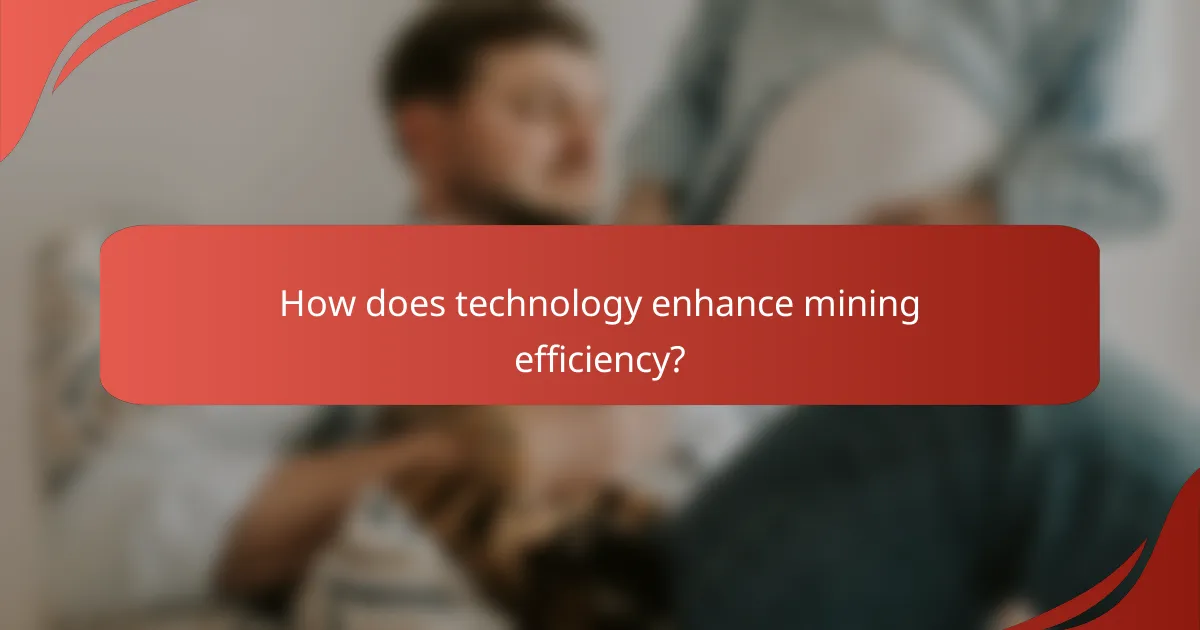
How does technology enhance mining efficiency?
Technology enhances mining efficiency by automating processes, optimizing resource management, and reducing operational costs. These advancements lead to increased productivity and lower environmental impact, making mining operations more sustainable.
Automation in mining operations
Automation in mining involves using machines and software to perform tasks traditionally done by humans. This can include drilling, hauling, and processing materials, which significantly speeds up operations and reduces labor costs.
For instance, autonomous trucks can operate continuously, transporting materials without the need for breaks, which can increase output by a notable percentage. However, companies should consider the initial investment and ongoing maintenance costs associated with implementing automation technologies.
Data analytics for resource management
Data analytics plays a crucial role in managing resources efficiently by analyzing large datasets to inform decision-making. By leveraging predictive analytics, mining companies can forecast demand, optimize supply chains, and reduce waste.
For example, using data analytics can help identify the most productive areas of a mine, allowing for targeted extraction that maximizes yield. Companies should ensure they have the right tools and expertise to interpret data effectively, as poor analysis can lead to costly mistakes.
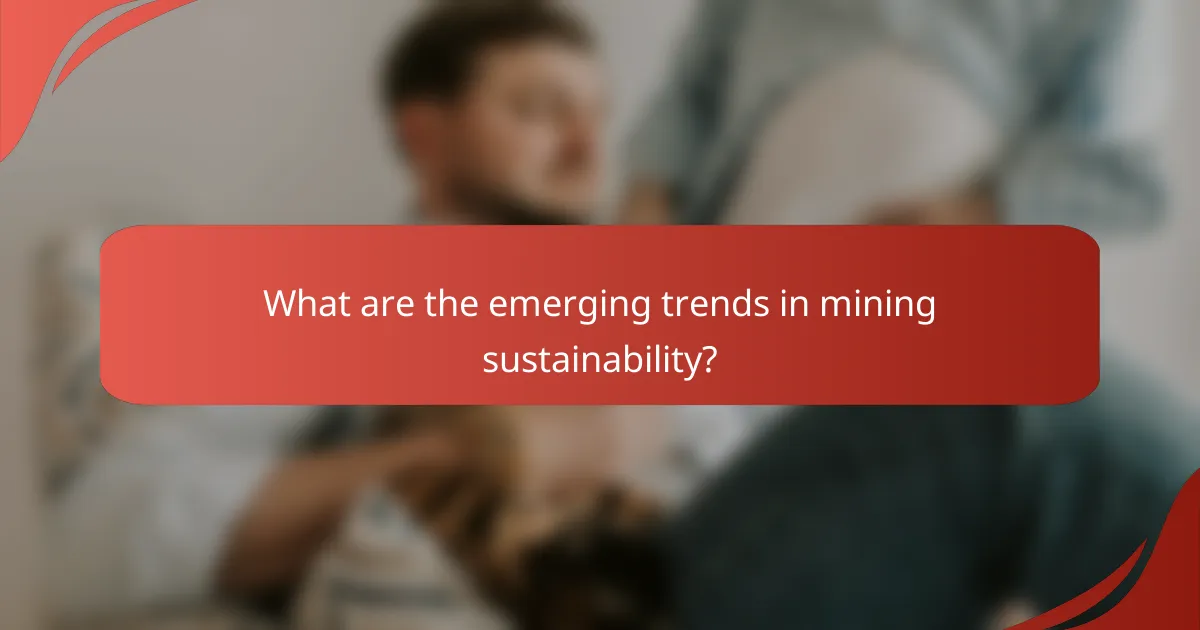
What are the emerging trends in mining sustainability?
Emerging trends in mining sustainability focus on reducing environmental impact while enhancing operational efficiency. Key areas include carbon capture technologies, blockchain for supply chain transparency, and innovations in eco-friendly materials.
Carbon capture technologies
Carbon capture technologies are designed to capture carbon dioxide emissions produced during mining operations. These systems can significantly reduce greenhouse gas emissions, contributing to a lower carbon footprint. For instance, some mines are implementing direct air capture systems that can remove CO2 from the atmosphere, potentially capturing thousands of tons annually.
When considering carbon capture, it’s essential to evaluate the costs and energy requirements associated with these technologies. While initial investments may be high, long-term savings and regulatory compliance can justify the expenditure. Mines should also explore partnerships with technology providers to optimize implementation.
Blockchain for supply chain transparency
Blockchain technology enhances supply chain transparency in mining by providing a secure and immutable ledger for tracking materials from extraction to end-use. This transparency helps ensure ethical sourcing and compliance with environmental regulations, which are increasingly important to consumers and investors.
Mining companies can leverage blockchain to verify the origins of minerals, reducing the risk of conflict minerals entering the supply chain. Implementing blockchain can also streamline processes and reduce fraud, ultimately leading to improved operational efficiency. Companies should consider pilot projects to test blockchain applications before full-scale implementation.
Innovations in eco-friendly materials
Innovations in eco-friendly materials focus on developing alternatives to traditional mining inputs that minimize environmental impact. For example, biodegradable materials are being explored for use in mine construction and rehabilitation, reducing long-term waste and pollution.
Additionally, the use of recycled materials in mining operations can significantly decrease the demand for virgin resources. Companies should assess the feasibility of integrating these materials into their processes, as they can lead to cost savings and enhanced sustainability. Staying informed about new developments in eco-friendly materials is crucial for maintaining a competitive edge in the industry.
